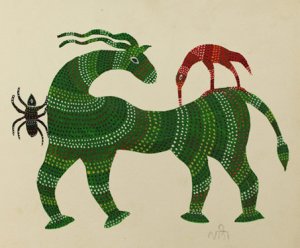Ancient Bhil Art
Art is reflective of the culture and background it originates from. The multiple layers of Bhil art are something to be admired. This type of art originates from the tribal or Adivasi community from the central belt of India namely from the states of Madhya Pradesh, Gujarat, Maharashtra, Chhattisgarh and Rajasthan.
As per recent surveys, the predominant occupation of the population is small-time agriculturalists and landless laborers.
The art demands for intrinsic simplicity which is synonymous to the everyday life of the tribe. Bhil tribal art is reflective of the organic connection the Bhils have to nature.
Bhils have a primordial relationship with nature which gives importance to the changing seasons and elemental worship so as to have a successful harvest. Even the materials used for the painting generally are naturally obtained pigments, neem twigs as brushes on clay walls, a form of frescoes (mittichithra).
The paintings are constructed as large, mythical and often delusive images which are filled in with even dots on a contrasting bright background. The dots being the most noticeable attribute of the Bhil art style, are repeated to cover the whole background.
Complementary colors and the style similar ‘pointillism’ that originated in the neo-impressionist art in the 1880s which is a technique of painting in which small, distinct dots of color are applied in patterns to form an image. It is often said that the dots symbolize the grain (maize) that is consumed which provides a livelihood to a large section of the community.
These dots are used to make pictures of deities and ancestral folklore carrying on for generations. Most of the art that is produced by the Bhil community is by the women who have been said to have been taught by their mothers.
This skill was a part of the informal education which has become part of the cultural identity of the Bhil community. There has also been a gradual introduction of modern life and technology that has found a space in modern interpretations of Bhil art.
The simplistic imagery of this art that reflect the purity of nature and life make imperfections something to be desired and teach us to enjoy the fundamental symbolism of life.





